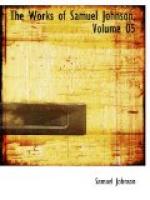NOTE XXXV.
As this is the chief scene of enchantment in the play, it is proper, in this place, to observe, with how much judgment Shakespeare has selected all the circumstances of his infernal ceremonies, and how exactly he has conformed to common opinions and traditions:
Thrice the brinded cat hath mew’d.
The usual form in which familiar spirits are reported to converse with witches, is that of a cat. A witch, who was tried about half a century before the time of Shakespeare, had a cat named Rutterkin, as the spirit of one of those witches was Grimalkin; and when any mischief was to be done, she used to bid Rutterkin go and fly; but once, when she would have sent Rutterkin to torment a daughter of the countess of Rutland, instead of going or flying, he only cried mew, from whence she discovered that the lady was out of his power, the power of witches being not universal, but limited, as Shakespeare has taken care to inculcate:
Though his bark cannot be lost,
Yet it shall be tempest-tost.
The common afflictions which the malice of witches produced, were melancholy, fits, and loss of flesh, which are threatened by one of Shakespeare’s witches:
Weary sev’n nights, nine times nine,
Shall he dwindle, peak, and pine.
It was, likewise, their practice to destroy the cattle of their neighbours, and the farmers have, to this day, many ceremonies to secure their cows and other cattle from witchcraft; but they seem to have been most suspected of malice against swine. Shakespeare has, accordingly, made one of his witches declare that she has been killing swine; and Dr. Harsenet observes, that, about that time, “a sow could not be ill of the measles, nor a girl of the sullens, but some old woman was charged with witchcraft.”
Toad, that under the cold stone,
Days and nights hast thirty-one,
Swelter’d venom sleeping got,
Boil thou first i’ the charmed pot.
Toads have, likewise, long lain under the reproach of being by some means accessary to witchcraft, for which reason Shakespeare, in the first scene of this play, calls one of the spirits Padocke, or Toad, and now takes care to put a toad first into the pot. When Vaninus was seized at Tholouse, there was found at his lodgings, “ingens bufo vitro inclusus,” a great toad shut in a vial, upon which those that prosecuted him “veneficium exprobrabant,” charged him, I suppose, with witchcraft.
Fillet of a fenny snake,
In the cauldron boil and bake:
Eye of newt, and toe of frog;—For
a charm, &c.
The propriety of these ingredients may be known by consulting the books De Viribus Animalium and De Mirabilibus Mundi, ascribed to Albertus Magnus, in which the reader, who has time and credulity, may discover very wonderful secrets.




